響沙灣蓮花酒店,內(nèi)蒙古 / PLAT ASIA
可持續(xù)沙漠建筑
設(shè)計(jì)公司:PLAT ASIA
位置:中國(guó)
類型:建筑 景觀
材料:石材 砂巖 鋼 膜
標(biāo)簽:Inner Mongolia Kubuqi 內(nèi)蒙古 庫布齊
分類:休閑娛樂 商業(yè)建筑 酒店
蓮花酒店位于中國(guó)內(nèi)蒙古庫布齊沙漠的響沙灣。
Lotus Resort is located in Xiangshawan Desert, a part of Kubuqi Desert, Inner Mongolia, China.
▼隱入沙脊線的蓮花,the project embedded in the desert
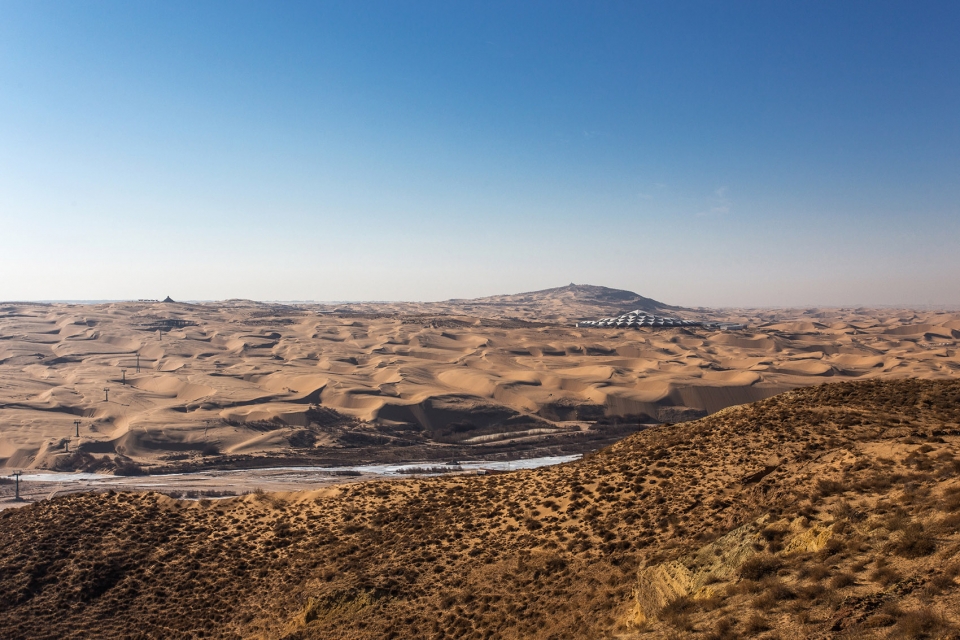
“陣”和“蓮花” | Chinese ‘ZHEN’ and “Lotus”
作為我們關(guān)鍵的結(jié)構(gòu)生成理念,中國(guó)傳統(tǒng)的“陣”的理念在設(shè)計(jì)中起到很大作用,“陣”通常指有序穩(wěn)定的重復(fù)。蓮花形式生成的邏輯源自簡(jiǎn)單等角度旋轉(zhuǎn)的正方形,旋轉(zhuǎn)的過程也形成了一系列三角形,這種簡(jiǎn)單幾何體的旋轉(zhuǎn)重復(fù)增強(qiáng)了建筑的力量感。考慮到結(jié)構(gòu),日照和風(fēng)沙,我們集合了功能、形式和景觀,生成了蓮花的形狀。蓮花也深深植根于中國(guó)傳統(tǒng)文化哲學(xué)的理念,在茫茫沙漠帶給游客繾綣鄉(xiāng)情。
As our core concept, the traditional Chinese philosophy of ‘Zhen’ has been celebrated in the design, which means replica of the identical. The logic of the form comes from simple rotations of squares, which would result in a delicate series of triangles that accentuate the visual appearance. In consideration of structure, shading and wind, we integrated function, form and landscape, resulting in a form of lotus. Additionally, lotus has been deeply rooted in Chinese aesthetic philosophy, which would gain the visitors a scent of nostalgia even in the barren desert.
▼酒店鳥瞰,aerial view
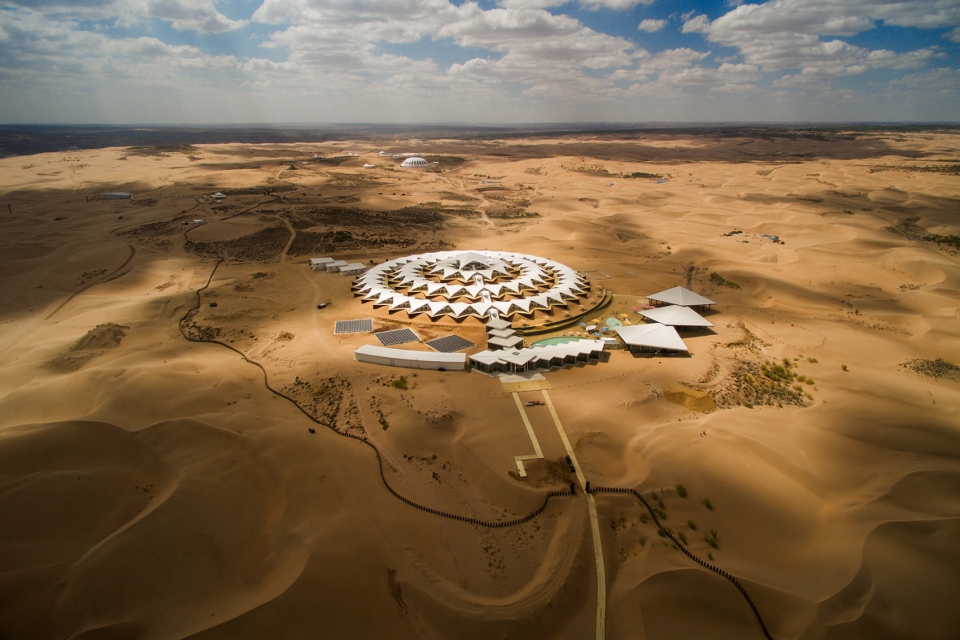
▼一系列三角形的旋轉(zhuǎn)重復(fù)增強(qiáng)了建筑的力量感,a delicate series of triangles accentuate the visual appearance
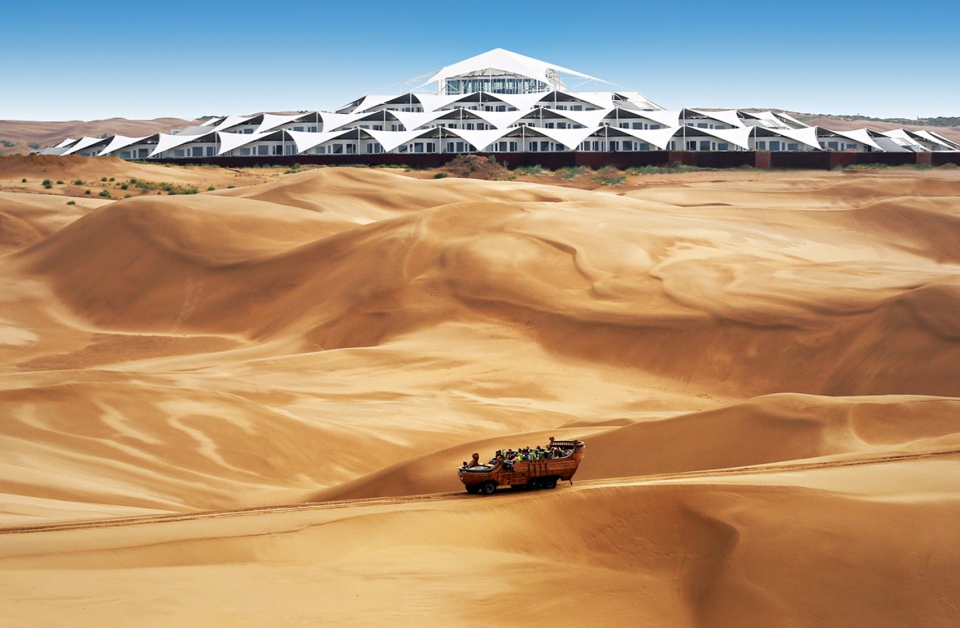
面向未來的建筑 | Architecture Meant For Future
在空前的城市擴(kuò)張形勢(shì)下,我們講目光轉(zhuǎn)向在中國(guó)占有很大比例的地貌環(huán)境——沙漠,這很可能蘊(yùn)藏著未來巨大的城市發(fā)展機(jī)遇和可能。我們?cè)O(shè)計(jì)了響沙灣蓮花酒店,希望它不僅是能造福當(dāng)代的綠洲,更是為了下一代創(chuàng)造一種沙漠利用的可能性和啟發(fā)。蓮花酒店是響沙灣沙漠城市計(jì)劃的一部分。
With the unprecedented urban expansion, it would be reasonable to presume that desert, the most neglected portion of terrain in China, would probably bear the future opportunity of urban development. By designing the Xiangshawan Desert Lotus Hotel, we aim for not only an oasis that would be enjoyed by the current generation, but also the use of desert for urban expansion for generations to come. Lotus Resort is part of the Xiangshawan Desert development, which resides in Kubuqi Area.
▼雪景中的酒店,hotel in the snow-covered landscape
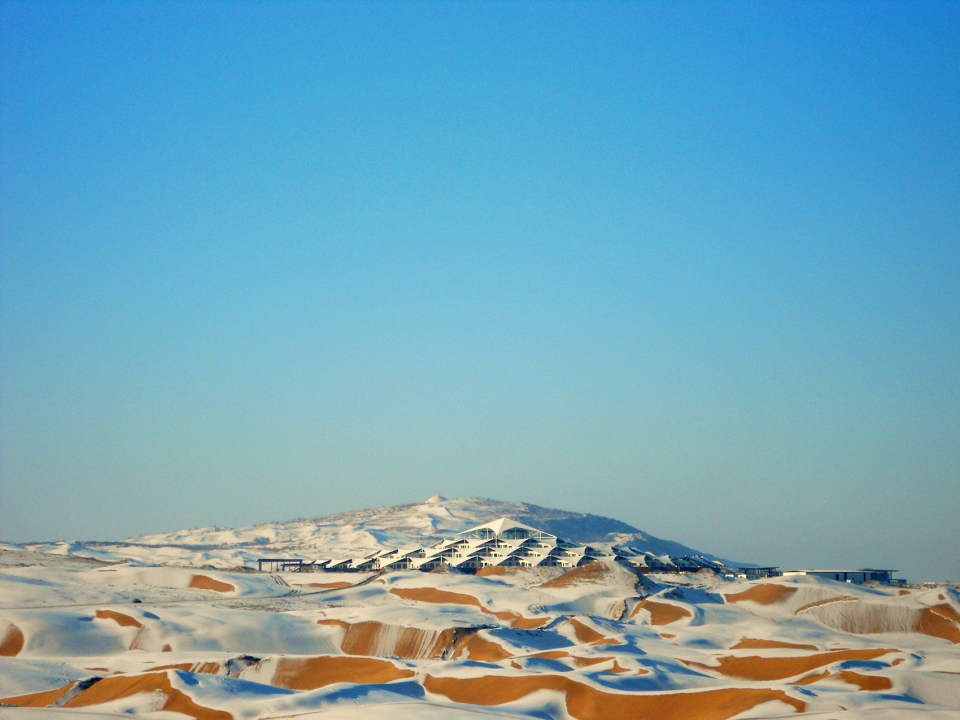
深入自然的結(jié)構(gòu) | Structure Tailored To Nature
為了在沙漠中做出符合地質(zhì)環(huán)境的建筑,我們研究出一個(gè)新的結(jié)構(gòu)系統(tǒng),以特定的鋼板固定流沙,就像沙海浮舟一樣的獨(dú)特地基基礎(chǔ),基礎(chǔ)在沙子均衡的作用力下保持平衡。同時(shí),我們使用輕鋼結(jié)構(gòu)降低對(duì)基礎(chǔ)的壓力。
In order to make the design buildable in its special geographic context, we invented a new structural system that would be fixed in fluid sands by steel panels, which would function as a boat floating in the desert that carries the super-structure, while the sub-structure would be in relevant equilibrium due to the constant forces exerted by sands. Also, walls are load-bearing structures in order to reduce the pressure on base.
▼建筑以特定的鋼板固定流沙,steel panels are used to fix the structure in fluid sands
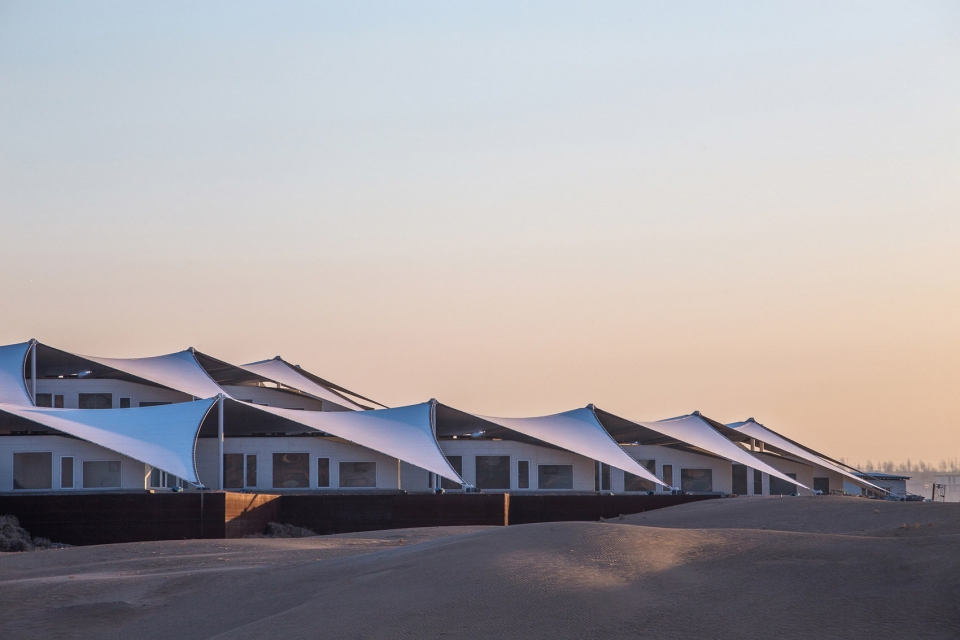
▼晚霞中的“沙海浮舟”,a “boat” floating in the desert
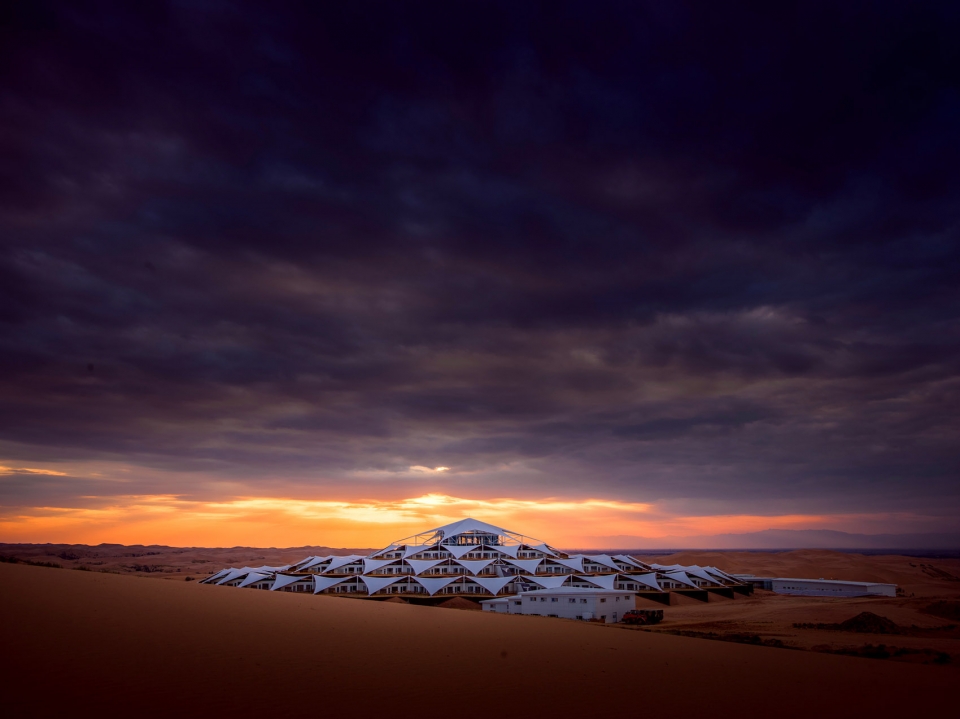
反哺環(huán)境的建筑 | Architecture Nurtured By Context
由于該地區(qū)建筑材料和有經(jīng)驗(yàn)的工人的匱乏,我們特殊定制了當(dāng)?shù)貜V泛使用的一種砂做裝飾材料,這不僅降低了投入,更減少了項(xiàng)目中的碳排放,以及未來持續(xù)的耗費(fèi),因?yàn)檫@給當(dāng)?shù)厣匙淤Y源的再利用以可能。
Due to the drastic lack of finish materials and skilled workers in the area, we customized a new kind of finish material from sands, which pervade in the local context for the project. This not only reduced the capital investment and carbon footprint in the project, but future maintenance cost as well, since it would be possible for the local to reproduce the finish material.
▼以膜結(jié)構(gòu)覆蓋的屋頂平臺(tái),roof terrace covered with membrane
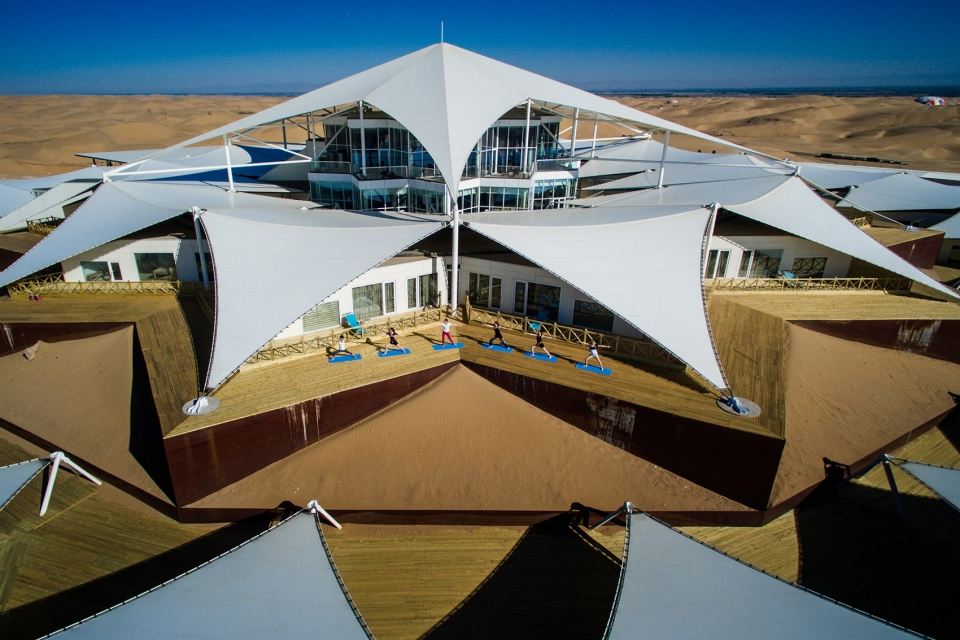
被動(dòng)式節(jié)能建筑 | Passive Architecture
酒店總面積達(dá)30700㎡,但不會(huì)產(chǎn)生想象中的溫室氣體排放。代替了高科技設(shè)備,比如光伏管、太陽能電池等,我們用最原始的方式降低碳排放。比如,膜結(jié)構(gòu)不僅是一種視覺景觀,更承擔(dān)著室內(nèi)遮陽的作用,預(yù)估在冷卻系統(tǒng)上能降低碳排放及電能的消耗。通過類似的手法,建筑對(duì)比使用科技手段帶來的舒適性擁有更低能耗。蓮花的形式源自浩瀚沙漠中沙丘的形式,同時(shí)考慮到沙漠化,日曬,風(fēng)荷載及雨水收集的相關(guān)因素。
With a total area of 30700㎡, the hotel would not create as much carbon footprint as imagined. Instead of utilizing high-tech equipment such photovoltaic panels and solar batteries, we seek the most primitive methods of reducing carbon emission. For instance, the membrane is not only an eye-catching element, but also a passive design strategy to reduce solar gain for the interior, which has considerably reduced the carbon-footprints and electricity costs incurred by mechanical cooling systems. By using similar strategies, the building would become less vulnerable compared to buildings that are equipped with too much high-tech. Also, the form of lotus is a logical result from the purpose of sand stabilization, sun-shading, wind-load bearing and rainwater collection.
▼從水池區(qū)域望向酒店,view to the hotel from the pool area
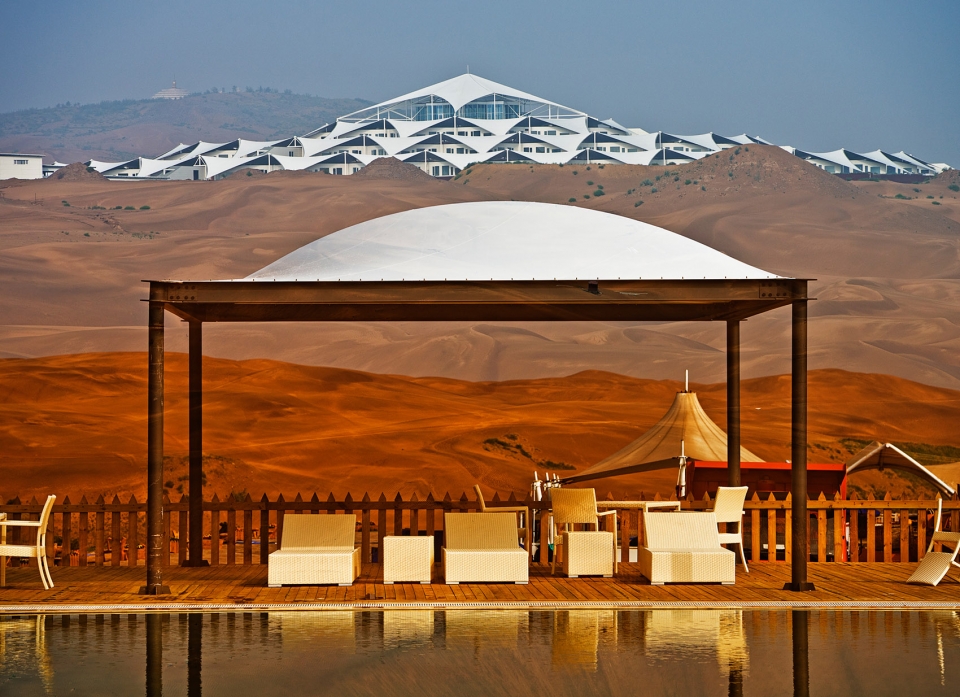
▼配套水池設(shè)施,hotel pool and facilities
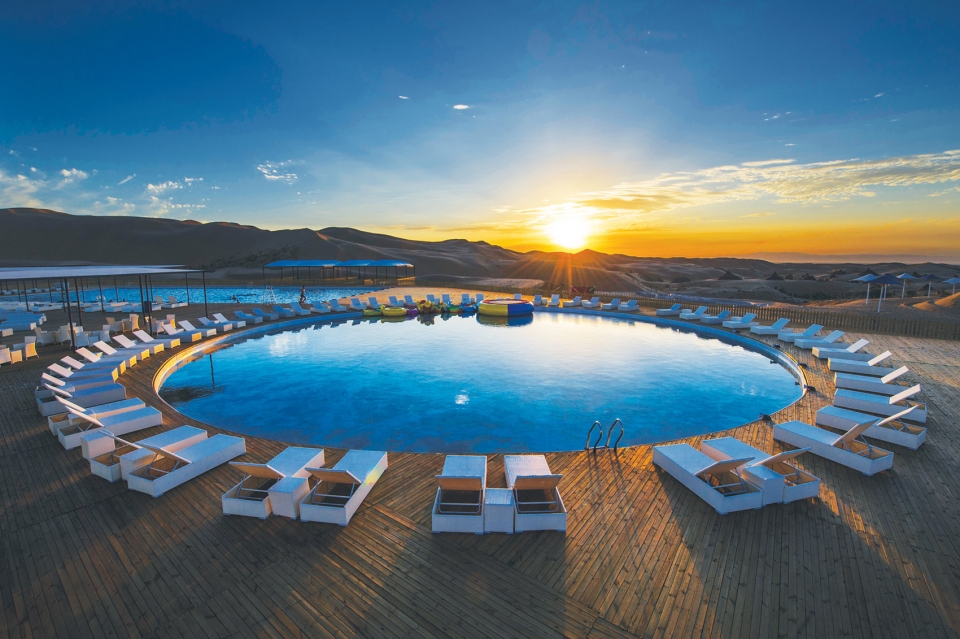
▼蓮花的形式源自浩瀚沙漠中沙丘的形式,the form of lotus is a logical result from the purpose of sand stabilization

▼平面圖,plan
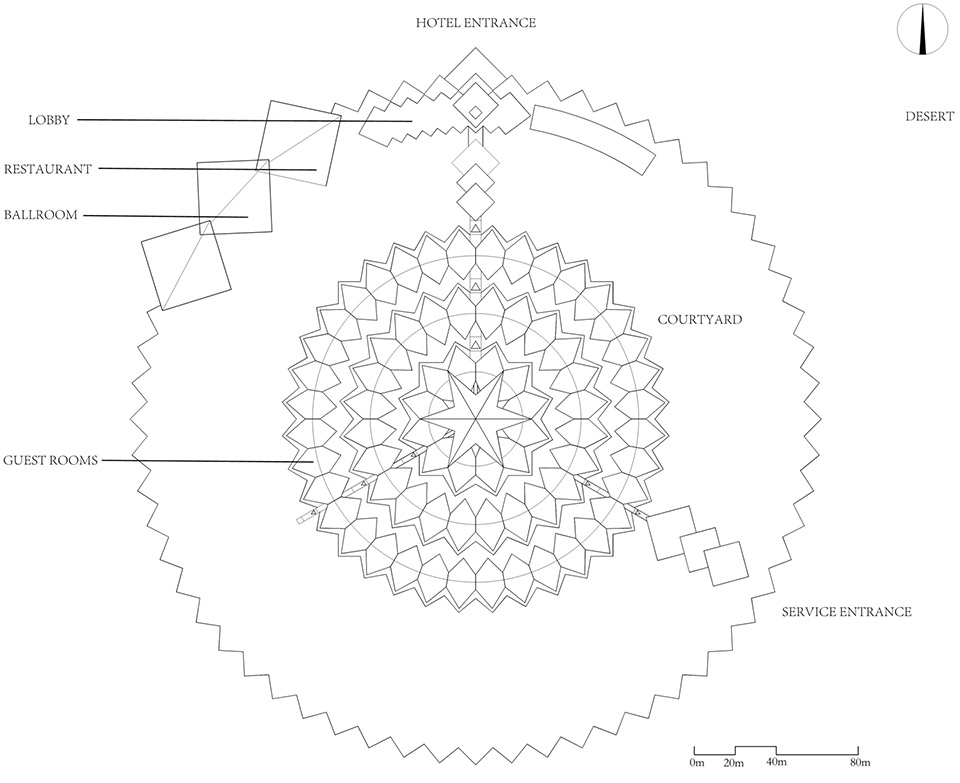
▼立面圖,elevation

項(xiàng)目名稱:響沙灣蓮花酒店
項(xiàng)目地點(diǎn):內(nèi)蒙古,庫布齊沙漠
業(yè)主單位:內(nèi)蒙古響沙灣旅游集團(tuán)
設(shè)計(jì)單位:PLAT ASIA(北京普拉特建筑設(shè)計(jì)有限公司)
設(shè)計(jì)團(tuán)隊(duì):邊保陽,鄭東賢,前田聰志,李雙全,喬文科,刀慧玲,李豆豆
設(shè)計(jì)類型:規(guī)劃,建筑,室內(nèi),景觀
施工圖設(shè)計(jì):北京華誠(chéng)博遠(yuǎn)建筑工程有限公司
建筑攝影:存在建筑-建筑攝影; PLAT ASIA
建筑面積:30,700㎡
占地面積:50,000㎡
最大高度:40m
建筑結(jié)構(gòu):輕質(zhì)鋼結(jié)構(gòu)
結(jié)構(gòu)材料:鋼,膜結(jié)構(gòu)
裝飾材料:砂
設(shè)計(jì)時(shí)間:2006-2014
建成時(shí)間:2016
Project Name: Xiangshawan Desert Lotus Hotel
Location: Kubuqi Desert, Inner Mongolia, China
Client: Xiangshawan Tourism
Architects: PLAT ASIA
Design Team: Baoyang Bian, Donghyun Jung, Satoshi Maeda, Shuangquan Li, Wenke Qiao, Huiling Dao, Doudou Li
Type: Masterplan, Architecture, Interior, Landscape
Construction Design: Beijing Huachengboyuan Engineering Technology Group
Photograph: Arch-Exist; PLAT ASIA
Total floor area: 30700㎡
Site area: 50,000㎡
Max Height: 40m
Construction: Light Weight Steel Structure
Structure material: Steel, Membrane
Decoration material: Sand
Design Period: 2006-2014
Completion time: 2016
來源:本文轉(zhuǎn)載自谷德設(shè)計(jì)網(wǎng)(gooood)
我們重在分享,尊重原創(chuàng)。如涉及作品內(nèi)容、版權(quán)和其它問題,請(qǐng)與本網(wǎng)聯(lián)系,我們將在第一時(shí)間刪除內(nèi)容!
- 時(shí)間 2019-03-06 /
- 作者 gooood /


